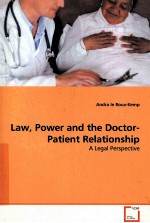

LAWPDF电子书下载
- 电子书积分:11 积分如何计算积分?
- 作 者:POWER AND THE DOCTOR-PATIENT RELATIONSHIP A LEGAL PERSPECTIVE
- 出 版 社:VDM VERLAG DR.MULLER
- 出版年份:2011
- ISBN:3639341376
- 页数:282 页
Chapter 1: Introduction 1
1.1.Background 1
1.2.Identifying the doctor and the patient in health service delivery 5
1.3.When does a doctor-patient relationship come into being? 9
1.4.Aim and methodology 13
1.5.Research question and underlying assumptions 16
1.6.Outline of study 17
1.6.1.Chapter 2 17
1.6.2.Chapter 3 17
1.6.3.Chapter 4 18
1.6.4.Chapter 5 19
1.6.5.Chapter 6 19
1.6.6.Chapter 7 20
1.6.7.Chapter 8 20
PART A 22
Chapter 2: The historical development of the doctor-patient relationship and the culture of medical care 22
2.1.The historical development of the doctor-patient relationship 23
2.1.1.Primitive society 25
2.1.2.The Greek medical tradition (± 600- 100 B.C.) 27
2.1.3.Classical, medieval and early modern societies (1200-1600A.D.) 29
2.1.4.Modern western societies (1700-1900A.D.) 31
2.1.5.Postmodern societies 32
2.2.The culture of medical care 34
2.2.1.Professionalism and the regulation of the medical profession 34
2.2.2.Social roles and the doctor-patient relationship 41
2.2.2.1.The physi?an’s role 42
2.2.2.2.The sick role 44
2.2.3.Professionalism, authority and the doctor-patient relationship 45
2.2.4.Power and the doctor-patient relationship 52
2.3.Conclusion 56
Chapter 3: Medical decision-making and the doctor-patient relationship in a paternalistic setting 58
3.1.Defining medical paternalism 59
3.2.Medical decision-making in a paternalistic medical setting 65
3.3.Autonomy, dignity, self-determination and beneficence in medical decision-making 71
3.4.Ajuridical response to traditional paternalism in medical decision-making 79
3.4.1.Informed consent 81
3.4.1.1.The origin of informed consent 82
3.4.1.2.The development of the doctrine of informed consent 88
3.4.1.3.The current status of the doctrine of informed consent 94
3.5.An evaluation of medical decision-making and the doctor-patient relationship 103
3.5.1.Standards of disclosure 105
3.5.2.Historical attributes 111
3.5.3.Practical considerations 112
3.5.4.The efficiency of the doctrine of informed consent 115
3.5.5.Recommendations 117
3.6.Conclusion 122
PART B 125
Chapter 4:The doctor-patient relationship in the medical marketplace 125
4.1.Definingthe business model in medical practice 126
4.2.The relevanoe of the business model to medical practice and the doctor-patient relationship 132
4.3.The business model and the power imbalances in the doctor-patient relationship 139
4.3.1.Informed consent 139
4.3.2.Patients’ rights, patient autonomy and the defiance of benefioence 146
4.3.3.The erosion of trust in the doctor-patient relationship 150
4.4.Conclusion 155
Chapter5: The fiduciary nature of the doctor-patient relationship 158
5.1.The doctor-patient relationship as a fiduciary relationship 159
5.2.The legal content of the fiduciary relationship between doctor and patient 167
5.3.The doctor as a fiduciary in the doctor-patient relationship 171
5.3.1.The duty of loyalty 172
5.3.2.The duty to act in the patient’s best interest 175
5.4.The patient as a beneficiary in the doctor-patient relationship 178
5.4.1.Right ore ntitlement to a benefit enforceable against the fiduciary 178
5.5.An evaluation of the doctor-patient relationship as a fiduciary lationship 182
5.6.Conclusion 188
PART C 191
Chapter 6: The doctor-patient relationship in an era of managed care 191
6.1.The history and development of managed care in health service delivery 193
6.2.The influence of managed care practices on the doctor-patient relationship 201
6.2.1.Access to health care 204
6.2.2.The new role of the physician in the doctor-patient relationship 210
6.2.3.Trust in the doctor-patient relationship and trust in managed care institutions 212
6.2.4.Informed consent in an era of managed care 217
6.2.5.Patient advocacy in an era of managed care 222
6.3.Conclusion 224
Chapter 7: Consumerism and the doctor-patient relationship 227
7.1.Consumer choice, patient autonomy and the ethical limits of consumer responsibility 231
7.2.Consumer protection in the doctor-patient relationship 235
7.3.Consumer empowerment and the doctor-patient relationship 240
7.4.Conclusion 242
Chapter 8: A proposed re-conceptualisation of the doctor-patient relationship to redress power imbalances 245
8.1.Are there power imbalances in the doctor-patient relationship? 246
8.2.Can the doctor-patient relationship be re-conceptualised, from a legal perspective, to redress the power imbalances inherent in the relationship? 250
8.2.1.The role of autonomy, dignity, self-determination and benefioence in the doctor-patient relationship 250
8.2.2.The doctrine of informed consent and the power imbalances in the doctor-patient relationship 252
8.2.3.The fiduciary nature of the doctor-patient relationship and the power imbalances inherent in the relationship 253
8.2.4.The role of trust in the doctor-patient relationship 255
8.3.Concluding remarks 258
Table of cases 260
Bibliography 264
Index 280
- 《LAW》POWER AND THE DOCTOR-PATIENT RELATIONSHIP A LEGAL PERSPECTIVE 2011
- 《RISK》POWER AND THE STATE AFTER FOUCAULT 2010
- 《POLICY》POWER and ORDER The Persistence of Economic Problems in Capitalist States 2222
- 《The Chinese in Vancouver》1945-80:The Pursuit of Identity and Power 1999
- 《Development》Poverty and Power in Pakistan The Impact of State and Donnr International on Farmers 2015
- 《SEX》MONEY AND POWER THE TRANSFORMATION OF COLLECTIVE LIFE 2004
- 《LOVE》POWER AND KNOWLEDGE TOWARDS A FEMINIST TRANSFORMATION OF THE SCIENCES 1994
- 《BLUE MAGIC:THE PEOPLE》POWER AND POLITICS BEHIND THE IBM PERSONAL COMPUTER 2222
- 《NEW WORLDS》ANCIENT TEXTS:THE POWER OF TRADITION AND THE SHOCK OF DISCOVERY 1992
- 《视网膜脱离手术学》(英)奇内尔(Chignell,A.H.)著;任高英,马志中译 1994
- 《蓄热技术及其应用》(奥地利)G. 培克曼,(奥地利)P. V吉利著;程祖虞,奚士光译 1989
- 《微距摄影》(德)马丁·西格里斯特,(德)埃尔温·施特格曼原著;冯小平,夏耀,汪庆芳翻译 2004
- 《霍克海默集》(德)霍克海默(Moriz Horkheimer)著;曹卫东编选 渠东等译 1997
- 《INTRODUCING DESIGNS FOR MAKING A FIRST IMPRESSION DIE GESTALTEN VERLAG》ROBERT KLANTEN 2005
- 《没有道德的市场 国际金融精英的失误》(德)苏珊娜·施密特著;马倩茹译 2012
- 《噢!你这条肥狗 漫画集》(德)乌利·施泰因(Uli Stein)著;唐艳梅译 2003
- 《科学程序设计引论 用Mathematica和C求解计算问题》(美)Joseph L.Zachary著;裘宗燕等译 2001
- 《卢卡契谈话录》(匈)卢卡契(Lukacs Georg)著;(匈)伊斯特万(Istvan Eorsi)编;郑积耀等译 1991
- 《会计与监管 基于监管 市场与制度的新见解》RobertoDiPietra,StuartMcLeay,JoshuaRonen编;中国人民银行会计财务司译 2016
